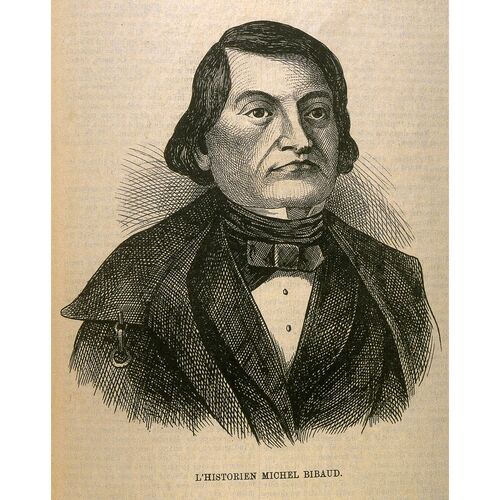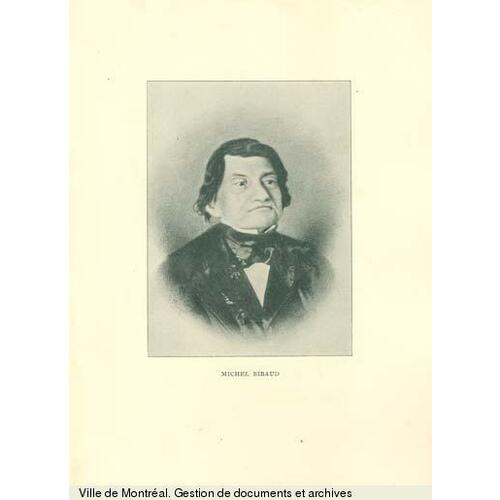BIBAUD, MICHEL, teacher, journalist, author, office holder, and justice of the peace; b. 19 Jan. 1782 in Côte-des-Neiges (Montreal), son of Michel-Ange Bibaud, a farmer, and Cécile-Clémence Fresne; m. 11 May 1812 Élizabeth Delisle, daughter of Joseph Delisle, a master cooper, in Montreal, and they had nine children; d. there 3 Aug. 1857.
Michel Bibaud came from a family of nine children and spent his childhood and adolescence at Côte-des-Neiges. At 18 he entered the Collège Saint-Raphaël in Montreal, where he studied until 1806; he then became a tutor. In 1813, while still in Montreal, he began a career as a journalist, working for Le Spectateur under its editor, Charles-Bernard Pasteur. Combining his new trade with the role of educator, he published L’arithmétique en quatre parties in 1816. The following year he went into partnership with Joseph-Victor Delorme to start L’Aurore, a political, scientific, and literary weekly. The paper merged with Le Spectateur canadien in 1819, of which Bibaud became editor in July. In October he accepted the same position with Le Courrier du Bas-Canada, a reform weekly recently founded by Delorme; the paper lasted only until December. Bibaud continued to write for Le Spectateur canadien until it ceased publication in 1822. He then concentrated mainly on teaching.
Bibaud embarked in 1825 on a new journalistic venture by founding La Bibliothèque canadienne and becoming its editor. This monthly journal featured historical, scientific, and literary articles. Bibaud allotted generous space to his own writings on the history of Canada and to the work of his contemporaries, particularly Jacques Viger, Jacques Labrie*, and Jean-Baptiste Meilleur*. He replaced La Bibliothèque canadienne in 1830 with L’Observateur, a reform weekly of a somewhat more political cast. However, this publication, which was both a gazette and a literary journal, did not become popular and ceased to appear in July 1831.
The preceding year saw Bibaud publish his Épîtres, satires, chansons, épigrammes et autres pièces de vers, the first collection of poetry by a French Canadian to appear in Canada. Neither contemporary nor 20th-century critics have been disposed to acclaim the work. Bibaud attempted to enlighten his audience about their misfortunes, to use irony in disclosing their defects and wrongdoings, and to present national and foreign heroes as ideals to emulate. But his poetry was moralizing, severe, bitter, and pessimistic, and it lacked originality, spontaneity, and warmth. A disciple of Horace and Boileau, whom he imitated slavishly, he was considered a third-rate classicist; according to Séraphin Marion, he composed his poems “like a lumberjack putting up his cottage.”
Bibaud launched a new reform monthly, the Magasin du Bas-Canada, in January 1832; its content was similar to the literary and scientific articles in La Bibliothèque canadienne. However, the journal did not clear the difficult hurdle of the first year and ceased publication in December. That year Bibaud published his L’arithmétique à l’usage des écoles élémentaires du Bas-Canada, as well as Quelques réflexions sur la dernière élection du Quartier-Ouest de la cité de Montréal, which was drafted under the auspices of the Constitutional Association and in collaboration with his brother Pierre.
In 1833 Bibaud accepted from the government the posts of clerk of the market and inspector of weights and measures in Montreal. Four years later he was appointed justice of the peace and that year he published his Histoire du Canada sous la domination française. Journalism continued to attract him, and in 1842 he started L’Encyclopédie canadienne, a monthly through which he hoped to further the arts, letters, and sciences. The experiment once again proved disappointing, and L’Encyclopédie canadienne ceased to appear in February 1843. As well, Bibaud became a translator for the Canadian Agricultural Journal in 1843, and for the Geological Survey of Canada, directed by William Edmond Logan*, in 1844. His Histoire du Canada et des Canadiens, sous la domination anglaise was also published in 1844.
For nearly 30 years Bibaud had worked tirelessly to raise the cultural level of his compatriots, whom he exhorted to intellectual effort. Despite unremitting work, repeated complaints, and sometimes severe reprimands, he never managed to capture the public’s interest. His harsh, unpolished, dry style and the often moralizing tone of his writings, as well as his monotonous and slipshod way of presenting information in his weighty periodicals, no doubt put readers off and explain his lack of success.
As for Bibaud’s Histoire du Canada, although it broke new ground, it was received with disparagement and indifference. The chronological, factual narrative, written in a tedious style, was based to a large extent on the writings of Pierre-François-Xavier de Charlevoix* and William Smith*. Bibaud found it difficult to describe the development of Canadian political life. Biased as an historian, he wrote history from the British point of view. Calling himself a true reformer, he pronounced in favour of a constitutional monarchy while advocating responsible government. He was rather servile in his approval of the colonial government, but displayed extreme severity towards French Canadians, and in particular towards the Patriote party, which he considered incompetent, obsessed with wild doctrines, and caught up in a chimerical struggle.
Bibaud’s partisan spirit made him unpopular with his contemporaries. He had prepared a third volume of his history covering events from 1830 to 1837; nevertheless, because of the stands he had previously taken and the possibility of reprisals from the Patriote party, he refrained from publishing it. His son Jean-Gaspard brought it out in 1878, and the work was given a harsh reception by the critics. Little known, if not unknown, Bibaud’s Histoire du Canada sank from sight. Quebec historian Guy Frégault* calls it “biased history, antiquated history,” and considers it fortunate for Bibaud that oblivion saved him from ridicule.
Bibaud seems to have been a serious-minded, stern, surly man, given to moralizing. Frégault, who had little regard for him, finds his poetry shapeless, insipid, and pretentious, and his history shallow, derivative, and lacking in truth. He describes the man himself in unflattering terms: “His head was not exactly cast in the mould of Mirabeau’s. A wig, heavy – and symbolic – set askew on a flat skull, small but bright eyes, an outsize nose, puffy cheeks, a rough-hewn mouth, a protuberant chin.” Séraphin Marion compares him to “a pot-bellied bourgeois or a fussy bureaucrat,” while Camille Roy* speaks of his scornful and contemptuous manner.
Bibaud was withdrawn and apparently had a very disagreeable nature. Conscientious and persevering, he contented himself with what he earned by hard work. He seldom went out, and was satisfied to keep a few close friends with whom he sometimes played whist. But as a general rule he shut himself up in his room to write. His son François-Maximilien* said that he was a good and affectionate father, but he stressed that his imposing and serious demeanour was a barrier to intimacy.
After the second volume of his Histoire du Canada was published, Michel Bibaud continued to work as a translator until he was stricken with paralysis in 1856. His son Jean-Gaspard took him into his house, where he died on 3 Aug. 1857. He was buried two days later in the Côte-des-Neiges cemetery.
Michel Bibaud is the author of a number of works, all published in Montreal: L’arithmétique en quatre parties, savoir: l’arithmétique vulgaire, l’arithmétique marchande, l’arithmétique scientifique, l’arithmétique curieuse; suivie d’un précis sur la tenue des livres de comptes (1816); Épîtres, satires, chansons, épigrammes et autres pièces de vers (1830), an abstract of which was printed in the Magasin du Bas-Canada, 1 (1832): 21–31; L’arithmétique à l’usage des écoles élémentaires du Bas-Canada (1832); Quelques réflexions sur la dernière élection du Quartier-Ouest de la cité de Montréal (1832); Histoire du Canada sous la domination française (1837; réimpr., New York, 1968; 2e éd., Montréal, 1843); Histoire du Canada et des Canadiens, sous la domination anglaise, [1760–1830] (1844; réimpr., East Ardsley, Angl., et New York, 1968); and Histoire du Canada et des Canadiens, sous la domination anglaise, [1830–37], J.-G. Bibaud, édit. (1878). He also edited Gabriel Franchère*’s Relation d’un voyage à la côte du nord-ouest de l’Amérique septentrionale dans les années 1810, 11, 12, 13 et 14 (Montréal, 1820).
ANQ-M, CE1-51, 20 janv. 1782, 11 mai 1812, 5 août 1857. AUM, P 58, A2/63. Le Journal de Québec, 6 août 1857. Le Pays, 4 août 1857. Beaulieu et Hamelin, La presse québécoise, 1: 29–30, 34–35, 39, 42, 49–53, 67–69, 72–74, 81, 120, 127, 146, 188. DOLQ, 1: 216–18, 345–47. Réginald Hamel et al., Dictionnaire pratique des auteurs québécois (Montréal, 1976), 65–66. Pauline Perrault, “Bio-bibliographie de Michel Bibaud, journaliste, poète, historien” (thèse de bibliothéconomie, univ. de Montréal, 1951). J. [E.] Hare, Anthologie de la poésie québécoise du XIXe siècle (1790–1890) (Montréal, 1979). Lareau, Hist. de la littérature canadienne. Gérard Malchelosse, Michel Bibaud (Montréal, 1945). Frère Marcilien-Louis, “La pensée didactique de Michel Bibaud, versificateur (influences prépondérantes du xviiie siècle)” (thèse de ma, univ. d’Ottawa, 1949). Séraphin Marion, Les lettres canadiennes d’autrefois (9v., Hull, Qué., et Ottawa, 1939–58), 3: 167–202. Camille Roy, Nos origines littéraires (Québec, 1909). Fernande Roy-Chalifoux, “1837 dans l’historiographie québécoise des années 1840–1850” (thèse de ma, univ. du Québec, Montréal, 1975). L.-W. Sicotte, Michel Bibaud (Montréal, 1908). [F.-]M. Bibaud, “Michel Bibaud,” L’Opinion publique, 6, 13, 20, 27 déc. 1877; 3 janv. 1878. Bernardine Bujila, “Michel Bibaud’s Encyclopédie canadienne,” Culture (Québec), 21 (1960): 117–32. Albert Dandurand, “Littérature canadienne,” L’Enseignement secondaire au Canada (Québec), 11 (1931–32): 541–47. Guy Frégault, “Michel Bibaud, historien loyaliste,” L’Action universitaire (Montréal), 11 (1944–45), no.2: 1–7. Jeanne d’Arc Lortie, “Les origines de la poésie au Canada français,” Arch. des lettres canadiennes (Montréal), 4 (1969): 38–40. É.-Z. Massicotte, “La famille de Michel Bibaud,” BRH, 45 (1939): 100–2. “Ouvrages publiés par Michel Bibaud,” BRH, 19 (1913): 350–51. “Les revues de Michel Bibaud,” BRH, 13 (1907): 156–59. V. L. Schonberger, “Le journalisme littéraire de Michel Bibaud,” Rev. de l’univ. d’Ottawa, 47 (1977): 488–505. Claude Tousignant, “Michel Bibaud: sa vie, son œuvre et son combat politique,” Recherches sociographiques (Québec), 15 (1974): 21–30.
Cite This Article
Céline Cyr, “BIBAUD, MICHEL,” in Dictionary of Canadian Biography, vol. 8, University of Toronto/Université Laval, 2003–, accessed December 31, 2025, https://www.biographi.ca/en/bio/bibaud_michel_8E.html.
The citation above shows the format for footnotes and endnotes according to the Chicago manual of style (16th edition). Information to be used in other citation formats:
| Permalink: | https://www.biographi.ca/en/bio/bibaud_michel_8E.html |
| Author of Article: | Céline Cyr |
| Title of Article: | BIBAUD, MICHEL |
| Publication Name: | Dictionary of Canadian Biography, vol. 8 |
| Publisher: | University of Toronto/Université Laval |
| Year of publication: | 1985 |
| Year of revision: | 1985 |
| Access Date: | December 31, 2025 |


![L'historien Michel Bibaud [image fixe] Original title: L'historien Michel Bibaud [image fixe]](/bioimages/w600.8419.jpg)



